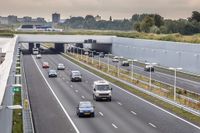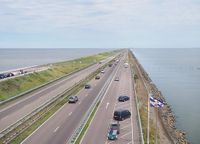Traffic chaos is expected in the Randstad region as the Dutch government braces for major disruptions during the NATO summit scheduled for June 23 to June 26, 2025. With thousands of delegates and world leaders converging on The Hague, officials are urging residents and visitors to steer clear of the area to avoid significant delays and road closures.
The NATO summit is anticipated to draw considerable attention, with around 8,500 attendees flying into the Netherlands, many of whom will arrive on private jets. This influx is expected to severely impact travel routes, particularly between Schiphol Airport and The Hague, one of the country’s most important cities.
In light of the expected congestion, the government has recommended that individuals work from home during the summit days, where possible. This measure aims to alleviate some of the traffic pressure on the already strained infrastructure. For those who must travel, public transport is being promoted as a viable alternative, although it is likely to be busier than usual.
Rail services will continue to operate normally, but increased passenger volumes are anticipated. Additionally, several bus and tram routes in The Hague will be affected, with some services altered or suspended altogether. Traffic officials are advising road users to prepare for long delays, closures, and diversions, especially around key motorways and city arteries.
Preparations for the summit have already begun. As of April 14, 2025, Johan de Wittlaan, a crucial thoroughfare linking Scheveningen, the Hubertustunnel, and the A44 motorway, is partially closed. This road will be completely shut down in both directions for four months, a decision made independently of the NATO summit.
Meanwhile, the situation at Schiphol Airport is further complicated by KLM’s announcement that it plans to seek compensation due to the summit. The airline estimates that airport capacity will be reduced by 20 percent as a result of the summit’s activities combined with ongoing runway maintenance. This reduction could exacerbate the already challenging travel conditions.
In an effort to manage the fallout from these disruptions, the Dutch government is establishing a central register for companies and organizations to report issues stemming from the summit. However, no official decision regarding potential financial compensation has been made as of yet.
As the NATO summit approaches, officials are calling for patience and flexibility from the public. The Netherlands is preparing to host some of the world’s most high-profile figures, and the government is keen to ensure that the event proceeds smoothly despite the anticipated challenges.
In related news, starting today, April 15, 2025, the daytime speed limit on the Afsluitdijk has been restored to 130 kilometers per hour. This change is part of a broader initiative by the Schoof I coalition, which includes the PVV, VVD, NSC, and BBB parties, to enhance traffic flow on certain highways.
The increase in speed limits will also apply to two additional highway sections: the A7 between Winschoten and the German border, and the A6 between Lelystad-Noord and the Ketelbrug. However, the restoration of the 130 km/h speed limit is limited to specific stretches of highway outside the Randstad region, as noise and nitrogen pollution constraints have made broader implementation challenging.
Last October, four routes totaling 117 kilometers were identified for this speed limit increase, which constitutes a small fraction of the 4,884 kilometers of the Dutch highway network. The sections that will see the new speed limit include:
- A7 Afsluitdijk between Stevinsluizen and Lorentzsluizen (44 km, in both directions)
- A7 between the Winschoten junction and the border with Germany (24 km)
- A6 between Lelystad-Noord and Ketelbrug (18 km)
- A37 between the Holssloot and Zwartemeer junctions (31 km)
The first three routes have already received approval and are now coming into effect, while the fourth section will see its speed limit increased later in 2025. This move is expected to improve travel times on these routes, but it highlights the ongoing challenges of balancing traffic efficiency with environmental concerns.
As the NATO summit and changes to speed limits come into play, residents and travelers in the Netherlands are urged to stay informed and plan accordingly. The government’s preparations reflect a commitment to ensuring safety and accessibility during a time of significant international attention.



